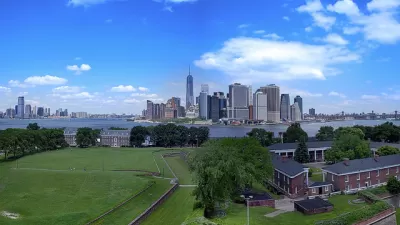The agency's report shows that inland-dwellers are just as likely as coastal types to be deeply affected by climate change.

Although those in the federal government who are critical of the science behind climate change have not retreated, the U.S. Army Corps of Engineers just released a comprehensive report “intended to help the 27 million people who live in 2,400 urban and rural communities across 204,000 square miles understand that the Ohio River and its tributaries will not escape climate disruption.”
James Bruggers, a reporter for The Courier-Journal of Louisville outlines major findings:
"► Increasingly potent storms will cause river levels to surge, risking major floods in low-lying cities like Louisville.
► More frequent and heavy droughts will likely dramatically reduce river volumes in some spots, putting in jeopardy drinking water supplies, barge traffic and power generation that relies on abundant water.
► Rising temperates and wild swings in river flows threaten to wipe out fish and other aquatic life.
► Economic losses could be ten times or more greater than from any other resource-based threats from the past."
Flooding in the Ohio River Valley, as well as heroic efforts to prevent it, is nothing new to the region. But the urgent tone of the report is worth noting. Brugger writes:
“The study concludes that the most dramatic effects are likely two decades away. But changes are happening more quickly than previously thought, and the time to start bracing for ‘a new normal’ and making plans to adapt is now.”
FULL STORY: Army engineers warn of brutal future for Ohio River region from climate change

Planetizen Federal Action Tracker
A weekly monitor of how Trump’s orders and actions are impacting planners and planning in America.

Map: Where Senate Republicans Want to Sell Your Public Lands
For public land advocates, the Senate Republicans’ proposal to sell millions of acres of public land in the West is “the biggest fight of their careers.”

Restaurant Patios Were a Pandemic Win — Why Were They so Hard to Keep?
Social distancing requirements and changes in travel patterns prompted cities to pilot new uses for street and sidewalk space. Then it got complicated.

California Homeless Arrests, Citations Spike After Ruling
An investigation reveals that anti-homeless actions increased up to 500% after Grants Pass v. Johnson — even in cities claiming no policy change.

Albuquerque Route 66 Motels Become Affordable Housing
A $4 million city fund is incentivizing developers to breathe new life into derelict midcentury motels.

DC Area County Eliminates Bus Fares
Montgomery County joins a growing trend of making transit free.
Urban Design for Planners 1: Software Tools
This six-course series explores essential urban design concepts using open source software and equips planners with the tools they need to participate fully in the urban design process.
Planning for Universal Design
Learn the tools for implementing Universal Design in planning regulations.
Heyer Gruel & Associates PA
JM Goldson LLC
Custer County Colorado
City of Camden Redevelopment Agency
City of Astoria
Transportation Research & Education Center (TREC) at Portland State University
Camden Redevelopment Agency
City of Claremont
Municipality of Princeton (NJ)





























